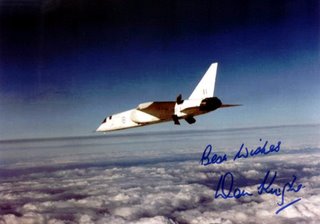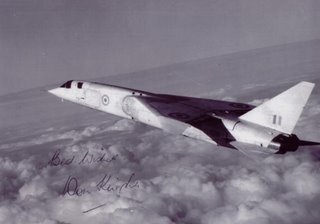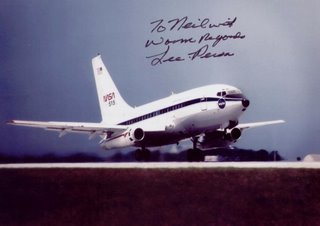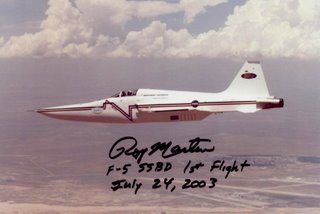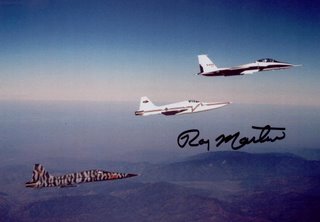Wg Cdr Walter F. Gibb D.S.O, D.F.C 1919 - 2006

 Wing Commander (ret) Walter F.Gibb won the D.S.O. and D.F.C. for his night fighter work during WWII. After the war, he joined Bristol Aircraft as a test pilot. He was co-pilot on the maiden flight of the Bristol Brabazon. In August 1952, he flew the maiden flight of the Olympus engined Canberra. He had flown over 75 types of aircraft.
Wing Commander (ret) Walter F.Gibb won the D.S.O. and D.F.C. for his night fighter work during WWII. After the war, he joined Bristol Aircraft as a test pilot. He was co-pilot on the maiden flight of the Bristol Brabazon. In August 1952, he flew the maiden flight of the Olympus engined Canberra. He had flown over 75 types of aircraft.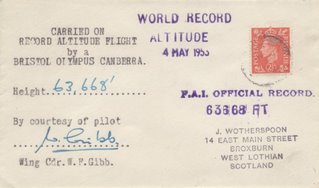 Walter Gibb and his observer, FM Piper, took off from Filton , near Bristol, on May 4 , 1953 in an English Electric Canberra bomber powered by two Bristol Olympus engines. The Canberra reached an altitude of 63,668 ft, more than 4,000 ft higher than the previous record. Cover carried on the flight, signed by Wing Cdr. Gibb. "2 of 7 flown" note on reverse
Walter Gibb and his observer, FM Piper, took off from Filton , near Bristol, on May 4 , 1953 in an English Electric Canberra bomber powered by two Bristol Olympus engines. The Canberra reached an altitude of 63,668 ft, more than 4,000 ft higher than the previous record. Cover carried on the flight, signed by Wing Cdr. Gibb. "2 of 7 flown" note on reverse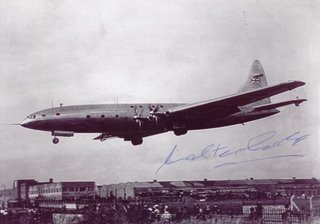
Wing Commander Walter Gibb was twice decorated for gallantry as a night fighter pilot before becoming a test pilot with the Bristol Aeroplane Company, when he flew the Brabazon and Britannia airliners; during the early 1950s he flew a modified Canberra bomber, twice breaking the altitude record for an aeroplane.
Gibb and his observer, FM Piper, took off from Filton, near Bristol, on May 4, 1953 in an English Electric Canberra bomber powered by two Bristol Olympus engines. Climbing to the west, the Canberra reached an altitude of 63,668 ft, more than 4,000 ft higher than the previous record.
Flying the same Canberra, fitted with more powerful Olympus engines, Gibb made an attempt to break his record on August 29, 1955. Again taking off from Filton, he climbed over the Bristol Channel towards Ireland and levelled off at 50,000 ft in order to burn off fuel to lighten the aircraft before continuing his ascent.
He turned east and finally reached a new record altitude of 65,876 ft (nearly 12.5 miles high) over Bristol. Gibb, who was flying solo, observed: "The last 500 ft took an awfully long time. It was the most difficult flying I have ever experienced."
The son of a Scottish mining engineer, Walter Frame Gibb was born near Port Talbot on March 26, 1919. After completing his education at Clifton College, he joined the aero-engine division of the Bristol Aeroplane Company as an apprentice in 1937.
In May 1940 he joined the RAF and trained as a pilot. He was identified as above average and selected to be a flying instructor despite his limited experience. After two years training students to fly twin-engine aircraft he joined No 264 Squadron flying Mosquitoes on long-range fighter sorties over the Bay of Biscay, giving support to the anti-submarine aircraft patrolling the area. On March 22, 1943 he shared in the destruction of a Junkers 88 bomber.
In low-level attacks against targets in northern France, Gibb damaged seven locomotives, and, during a later sortie, the formation he was leading destroyed two German fighters. In July he was awarded the DFC for his "skilful leadership, great courage and tenacity".
In July that year he was appointed as a flight commander with No 605 Squadron, and on September 14 led six Mosquitoes to provide support for eight Lancasters of No 617 (Dam Buster) Squadron which was due to make a daring low-level raid on the Dortmund-Ems Canal. But Gibb, flying ahead of the formation, reported very poor weather; the bombers turned back, although not before one of the veterans of the Dams Raid was lost.
The following night a further attempt was made. Gibb and his Mosquitoes went ahead and attacked the flak and searchlight positions near the canal. As the Lancasters prepared to bomb, three of the big bombers were shot down by anti-aircraft fire. When Gibb returned to base he learned that five of the eight, which included other survivors from the Dams Raid, had been lost.
Gibb went for a rest tour to the test squadron of the Central Flying School, where he flew many aircraft types and was assessed as an exceptional pilot. In September 1944 he was promoted to wing commander and given command of No 239 Squadron.
In a six-week period during February and March 1945 he was credited with shooting down five enemy aircraft during long-range night intruder sorties over Germany and France; and in May he was awarded the DSO. He left the RAF nine months later and returned to Bristols as a test pilot, becoming chief test pilot in 1955.
During the war the Bristol Company had started to design a "super-bomber" with a range of 5,000 miles. The idea was abandoned, but it led to the huge airliner, the Brabazon, with its eight engines, twin-coupled and buried in the wings.
On the morning of September 4, 1949 more than 10,000 people gathered to watch the chief test pilot, Bill Pegg, and his co-pilot Gibb complete the taxi tests before taking off on the aircraft's maiden flight. As the crowds on the ground cheered, the story was transmitted around the globe in what was one of the first uses of live outside broadcasting after the war.
In an era devoid of good news, such was the value of this aircraft that the Queen was introduced to the crew and all the newspapers ran stories about the event. Some 250 reporters and photographers, television and newsreel staff were on hand, more than had ever before assembled in Bristol for a single event.
Apart from Pegg, Gibb was the only other pilot to fly the Brabazon. On his first flight in command (the aircraft's thirteenth) the airliner suffered a hydraulic failure, and Gibb was forced to land the aircraft without the flaps. Eventually the elegant Brabazon was scrapped as being uneconomical.
Gibb carried out a great deal of the test flying of the turbo-prop Britannia. On one flight he was checking the stalling characteristics of the aircraft. As he selected the flaps up, the big airliner rolled on to its back (unknown to Gibb, one of the flaps had failed to retract).
After losing many thousands of feet, he managed to regain control. Asked later what he had done, he replied: "I undid the last action I had made." By putting the flaps back down, he had restored the balance of the aircraft.
In March 1955 Gibb took a Britannia to Johannesburg, with only one refuelling stop at Khartoum, arriving in just under 19 hours, some two hours quicker than the Comet jet airliner. This impressive performance was headline news in the following day's issue of The Daily Telegraph.
Over the next few years Gibb demonstrated the airliner on sales tours to many airlines, assisted in the training of their pilots and conducted many route-proving flights. In 1960 he retired from test flying to become head of service and technical support with the British Aircraft Corporation, which had absorbed Bristols. He held the post until 1978, when he became managing director, and later chairman, of British Aerospace Australia.
Gibb was modest about his many achievements. When asked in later life what had given him the greatest pleasure, he identified working as an apprentice on the Pegasus engine that powered the Wellesley aircraft that created a world long-distance record in November 1938.





